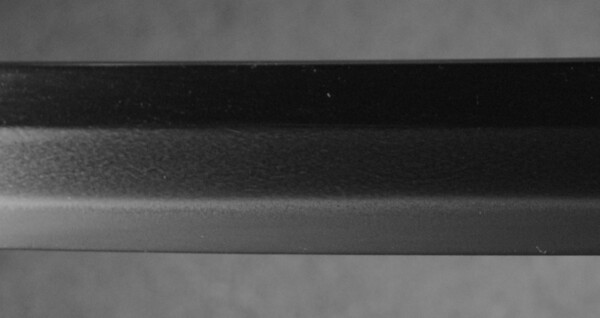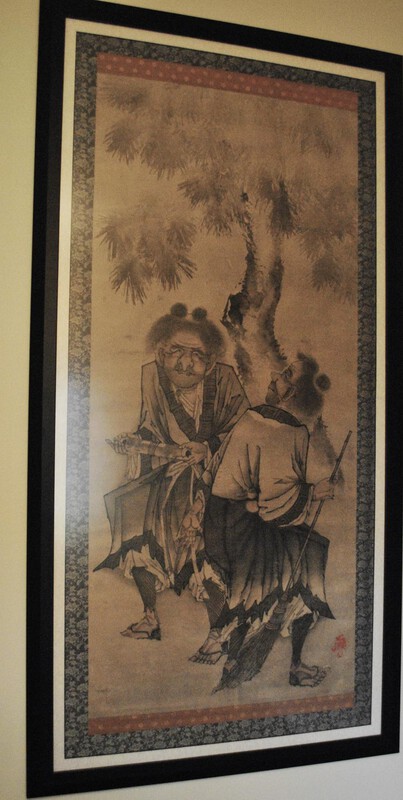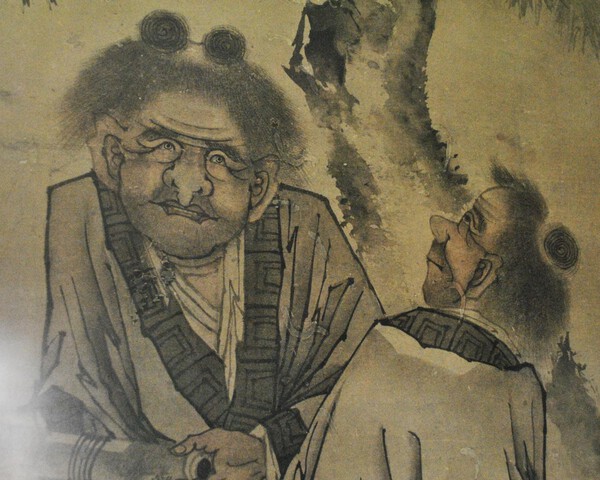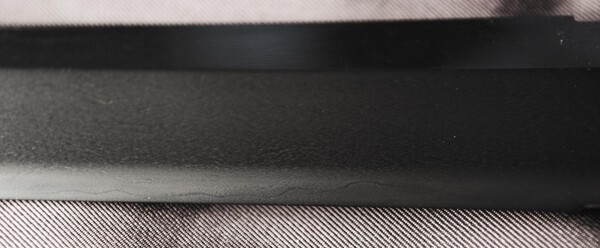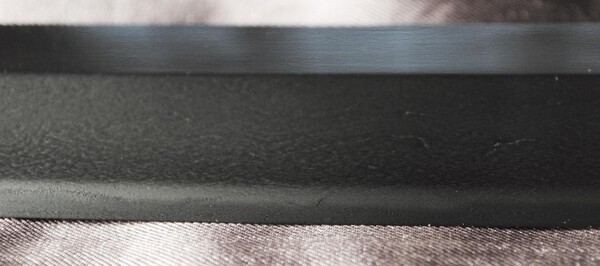-
Posts
3,046 -
Joined
-
Last visited
-
Days Won
73
Content Type
Profiles
Forums
Events
Store
Downloads
Gallery
Everything posted by paulb
-
If you do a quick search on this site you will find many suggestions. As a starting point I would take a look at Markus Sesko's website and blog it has a huge amount of information. Regarding books the connoisseurs book of Japanese swords by Nagayama is a good reference to have but will take a little patience to start to get best use from it. Also Markus' kantei books and other references are comprehensive and have a lot of very useful information.
-
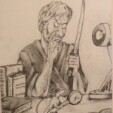
Nefarious Nihonto, Bogus Blades, And The Quest for Bad Papers
paulb replied to jt nesbitt's topic in Nihonto
If some of the longer term collectors here care to look back at their own beginnings I think many will find they bought a range of variable quality blades before they bought books. I have to admit that when I started it was much easier to buy a sword than it was a book on the subject, especially in English. Most of us will have searched round arms fairs and bought something we thought was an authentic bargain piece which later proved not to be. After buying one, two or more blades the reference book followed to try and better understand what you had. Mistakes made? Yes absolutely a lot but fortunately I was able to join a group of people (The Northern Token Society, thank you IanB) and learn a lot from them and their shared experience. Some of the benefit of being part of such society's has been replaced by technology and groups like this one where people an come and ask questions. It isn't a true replacement but it is a strong addition. Re; post an example of a fake paper- it is exactly same as an authentic paper but has the wrong attribution on it. The ones that caused the scandal originated with the NBTHK so were produced on their paper. There have been many discussions and arguments here about whether they are or are not worth considering. There are all sorts of reasons why a sword may still only have old papers but bottom line is the NBTHK don't recognize them and offered to repaper blades that had these attributions at no cost over a longish period of time so there is little justification for a sword coming out of Japan to still have green papers. As a purely personal viewpoint there is no correct way to collect. The right way is the one that suits the collector and gives them most enjoyment. The important thing is that they approach it with a foundation of knowledge and understanding so that the decisions they make are not made on false information or assumptions. Books play an essential role in that process but so does going through the early purchasing process and learning from mistakes made, we all have done that to a greater or lesser extent. -
I'll hold my hand up Bazza, I don't think would have gone to Muramasa as a first guess. My initial reaction would have been something a bit later. I am glad to say we continue to learn and hopefully don't take anything for granted.
-

New sword bought home by USMC vet from Tsing Tao 1945
paulb replied to Dean1981's topic in Military Swords of Japan
Hi Dean, It is very difficult to offer an opinion based on the images, not because they are bad but there is little if any detail to see in the blades current polish. I cant see any obvious major issues that would prevent it from polishing. However a good next step would be to show it to some other collectors and let them see it in hand. If you would like to drop me a pm telling me whereabouts you are in the UK I can put you in touch with local members of the Token of GB who could help well done on buying what looks to be an older and interesting work. -
combination of an O-gunome and choji with yo and nie-deki thrown in. Looks like very late Mino work
-

Japanese Swords & Furniture Museum of Fine Arts Boston
paulb replied to Babu's topic in Wanted to Buy
Bazza, The handling fee isnt about the postage it is managing the process of passing the item through customs. Whether justified or not is another question. -
I think what Robert says stills hold true for the major auction houses. They use a common form for all art objects Made by or by= confirmed to be by the artists hand Attributed to-=someone says its by the named artist but not guaranteed after= looks like their work but by somebody else Most of the larger auction houses have only grudgingly mentioned any form of papers believing their own expertise counts for more. Recently the only ones they have mentioned have been NBTHK. Also at one time Christies and Sotheby's both said that their normal guarantees of authenticity did not apply to Japanese arms and armour.. This may have changed in recent years but if so I haven't heard about it. I cant remember which London sale it was but a few years ago a whole raft of swords were catalogued and sold and it was only announced on the day that "Oh by the way these have Juyo papers". If I was the seller I think I would have been a little upset.
-

Japanese Swords & Furniture Museum of Fine Arts Boston
paulb replied to Babu's topic in Wanted to Buy
unless something has changed recently I have never paid duty on imported books -
Dear All, I think this has probably been discussed to death. The intention of the original post has long since been lost and I do not believe there is any benefit in the continued analysis of motivations character or whatever. While much of what you say regarding personal choice is beyond argument there is a complication. As most here will be aware I have had the honor of being Chairman of The Token Society of GB for 4.5 years. So whether I choose it it not if I write something about collecting it ceases to be a personal point of view and may be seen by some as advice or policy from an officer of a society I think, (don't know) that caused the reaction it did from Ray. Taken at face value it might have appeared to fly in the face of all the advice we and he give to new members when attempting to prevent them buying poor quality which is oversold or misrepresented (not something I have seen here BTW). The comments were unpleasant and I believe unjustified but the motives were not. Can we now draw a close to this and move on. Thank you Paul
-
Mark H I am both I think. I have been interested in fine art since I was a 5 or 6 year old. I have been a collector of firearms n the past but only those relating to a specific period in history. But my overriding passion for the past 35 years or so has been Japanese swords. I do believe in aiming for as high as you can and that it is better to have a few outstanding pieces than many mediocre (as I keep boring everyone by telling them) But life is not that black and white. I have bought sculpture from contemporary artists such as David William-Ellis and Hamish Mackie but also carved wooden work from amateur sculptors because what they had made was attractive, skillful and pleasing. Likewise with swords. I have a number of blades that I made considerable effort to acquire and they form a core collection of blades from a period I am particularly interested in. I also have several that are no where near that standard but have something of interest and merit. I do agree with Ray I see no merit in buying something just because it is cheap. There are always apparent bargains and they are usually that for a reason. However there are some that do not conform that are not top tier but that can still teach something (to me anyway). What I am totally against and I think in line with Ray is when people oversell what they have, make unrealistic claims about them and take advantage of the inexperienced. Such practice in the long term is totally destructive and damaging to the subject. Regrettably it isn't unique to swords.
-
Also I am not trying to justify a bad purchase, because it wasn't one. The comments regarding comparison to Yamashiro work wasn't because of what the papers said it was based on what I could see in the images. The educational aspect (for me only) was to try and compare the way this smith had tried to create a very tight itame hada and nie based suguha hamon. Would I have bought it at the full asking price-no probably not. Was it worth buying at what I paid for it to let me examine and compare close up I obviously thought so. I did not (as I said) buy it to add to or enhance a collection.
-
Oh Dear, I must admit when writing this yesterday I partly anticipated this type of response Ray but sort of hoped not. I am either an eternal optimist or stupid. I regret that I appear to have lost your respect. What is not acceptable is making statements such as "The Token Society looks like a joke every week that goes by" and comparing what I am saying to Trumps comments on Coronavirus. This is both inaccurate and extremely insulting. Taking the core point which I have either explained very badly or you have chosen to miss. I said very clearly that advice to buy the best you can is correct and what I also tell people to do. That does not mean that there are no works in existence that cannot be enjoyed even though they do not meet the established criteria.
- 33 replies
-
- 10
-

-
Hi Peter Yes it has NTHK NPO papers to Hosakawa Tadamasa dated to about 1860. To be honest and perhaps a little cynical it is one of those "safe harbor attributions" such as Echizen-seki, Shoami or Bungo Takeda. I looked up the school and this man was supposed to be the son of Hosakawa Tadayoshi but there is nothing i can see in the workmanship that explains how they reached that conclusion. I am not saying they are wrong I just don't understand the attribution. I think the date is reasonable though.
-
Some while ago I wrote about a sword I had bought from a dealer in the USA. I thought it was possibly worth revisiting the subject. On first review this was not a commercially attractive proposition.. It is a fairly short ubu, mumei katana dating from the end of the Edo period. The sword had been on a well known dealer website for some time, it had been shown at several arms fairs and been largely ignored. Based on this experience and the fact one is repeatedly told not to buy unsigned shinto or shin--shinto blades this was not a collection enhancing proposition. So I bought it, What I saw in the images on the website were interesting and it had a number of features I liked. I have listed a description below, which incidentally I think forms the basic information a seller should supply when advertising a sword for sale here or anywhere else.. Description:- A Shin-Shinto Katana Ubu, shinogi-zukuri iori-mune, chu kissaki. A very shallow sori which is slightly Koshi-zori. In shirasaya. Dimensions: Sugata 65.5cm Sori 1.2cm Motohaba 2.7cm Sakihaba 1.8cm Kasane 0.68cm Jigane: Extremely tight ko-itame and ko-mokume with frequent ji-nie and chickei. Closely resembling both Enju hada and Hizen Konuka hada Hamon: Chu-suguha in ko-nie with tight nioiguchi and much activity in the form of kinsuji, inazuma and sunagashi. Very bright and clear ko-nie throughout. Boshi; Ko-maru with slightly elongated return Nakago: Ubu mumei with Sujikai yasurimei possibly with kesho but indistinct. If I am honest with myself I bought this sword firstly because I wanted to compare it to much earlier Yamashiro based work I had and secondly because it was offered at almost half the original price! having spent time with it I have reached the conclusion that it is a very well made blade. The hada is clear and bright with chickei and ji-nie. The nioiguchi is bright, tight and beautifully interspersed with ko nie. All in all it is a good thing. It is also unmodified and healthy so it appears exactly as the maker intended. we are frequently and quite rightly advised to seek the very best we can afford a strive to improve our collections. This is advice I give to people regularly. From a purely commercial point of view buying this sword was not a good decision. It was of unpopular form, it would be difficult to sell on and it does not enhance or add greatly to my collection. However it is also extremely beautiful. It has numerous features and activities that one would want to find in a much more highly regarded work. The reason for posting this is not to decry the advice given as to what to buy. It is given based on sound experience and understanding and aimed at preventing less experienced people from making an error that they would regret. However we should also remember this is not a purely commercial activity. we buy swords because we are interested in them they have features we enjoy and we want to study. On occasion such a sword appears and we need to be open to the possibility that something that does not conform to all the good and sound advice can still deliver an incredible experience. Edit: added a tiff file of the sugata to give a clearer image: shin-shinto1.tif
- 33 replies
-
- 12
-

-
Its a typical summers day in the north of England. 60 mile per hour winds and occasional heavy showers. I thought I would try and lighten the mood a little by sharing some images of something I bought some 15 years ago. It is a large ink drawing scroll showing the two characters Jittoku and Kanzan. My understanding is that these two gentlemen were labourers at a temple. One considered himself a great poet and carried a scroll with him as a badge of office. the other is always shown with a broom. They invented their own language and spent their time laughing and joking with each other. Pilgrims hearing their jolly conversation used to greet them warmly only to receive a tirade of abuse! I bought it as it reminded me of me and my teacher two grumpy old ****** talking about something no one else in the room understood and scowling a lot:-)
-
- 6
-

-
I hear different ideas about colour. Most of the main references refer to colour as an indicator of both school and quality. I admit I find it very difficult to assess colour in steel unless it is set against something else. Some polishers will tell you they can achieve a range of hue variations based on the chemical composition of the final finish they apply. I have seen blueness in steel, especially early Yamashiro work but also in a sandai Tadayoshi blade. I have also seen what I think would be described as "blackness" as seen in northern province work. But unless it is fairly extreme I find it very challenging. Whether the views about quality are correct or not I have no idea.
-
A good result Chris and well done for seeing the potential. It is always good to see something that looks beyond hope returning from the dead. congratulations!
-
Honestly I don't know having no experience of current makers. However the market has not improved for them as far as I can see and based on recent reports there are fewer working smiths. there are no prominent names to the degree of Yoshindo Yoshihara who have enjoyed great success in recent decades. It is possible that the upsurge in interest in a younger and more diverse market may cause an increase in manufacture but of course this is no guarantee of innovation or improvement in quality.
-
During this period of enforced semi isolation I have been re-reading some of the books I first looked at 20+ years ago. One of these, The new generation of Japanese swordsmiths by Tamio Tsuchiko contains some fascinating material that I am sure I must have read originally and either forgotten or absorbed in to the subconscious. Some of the interesting points which came out of the interviews: One of the recurring themes was the focus of these post war smiths in trying to re-create the quality of swords from the Kamakura and Nambokucho. most felt this was largely unachievable although some felt they were making progress. Amata Akitsugu who perhaps came closest to recreating Kamakura quality work at the time said "many smiths say that Gendaito are as good as koto and it is true that in the perfection of their choji hamon and sugata some are as good or surpass some koto blades. Where they fail is in the Jigane." He spent many years smelting his own material as he tried to regain the qualities of earlier work. Other points of interest: Smiths working for the army making swords (albeit using traditional methods) were given a minimum quota of 10-12 swords per month. If you consider how long a smith would normally spend on a single sword I think it is not surprising that the quality of swords, even those made traditionally suffered under this pressure. I also enjoyed reading the Honami Kozon quotation "Jigane is the essence of the sword" (I now know where Michael Hagenbusch's and my much quoted phrase "Jigane is key" may have originated) There is a long interview with Nagayama (connoisseurs book of Japanese swords) describing his time with Honami Kozon which is a great insight in to one of the last of that great family. For any who haven't read this I think it is a very worthwhile volume offering an insight in to the dedication and efforts made by post war smiths to bring new life in to this subject.
- 17 replies
-
- 14
-

-
I think they are formed from different types of steel with varying carbon content being combined in the jigane. You see it a lot in Northern province blades (such as Norishige) who are often described as having dark steel. These are not made of ji-nie as other activity such as chickei are
-
Unfortunately I don't think there is a direct or single answer to either of the points raised gentlemen. From a purely personal perspective let me answer what I think is the easiest one first. No quality and good are not limited to ubu or slightly suriage blades. I have seen numerous O-suriage blades that have been shortened in such a way as to maintain or create an excellent sugata. As said in the meeting there are two areas I would consider regarding defining a good shape: 1. First and foremost is functionality. Regardless of what else we value in a sword it's primary function is to cut. And the various shapes developed over the last 1000 years are all aimed at improving cutting efficiency in specific ways. If the shape of the blade inhibits this function, or makes it less efficient it is not a good sword. (as said before personal opinion) 2. From an aesthetic point of view the shape should enhance and harmonise with all other aspects of the it jars the senses. The shape is effectively the frame for everything else and should work in unison to present an attractive whole. So I think I am saying two things. If it doesn't perform its function it isn't good. Regardless of what the shape and form is it should compliment the other features and enhance the whole. If it fails in these aspects then I don't think it is a good sword.
-
Dear All I just wanted to share with those here from other societies that like us have been unable to meet as normal our experience using Zoom We held our second meeting yesterday which was joined by 38 members predominantly from the UK but also from other parts of Europe and Japan (sorry for the late night again!!). Overall I think the meeting went well and certainly people seemed more confident with the technology. A couple of rules and things we did 1. All attendees were muted while the presentation was on and asked questions at the end when we had an open discussion. 2. We recorded the presentation only. This ensured attendees privacy and meant we did not have to seek individuals permission to release the recording. 3. The link to the recording was made available to members on request and held on Zoom for 30 days. I think this technology has great potential for our different societies not only during the current problems but later when we return to normal. They should not be seen as a replacement for face to face meeting but certainly are a very useful additional tool to help us learn together..
-
JT For what its worth at $450 you didn't pay large chunks of money for it and I think it is probably well worth that and more. As an aid to learning it has even more value. One lesson to learn though especially when looking at blades being sold on eBay from Japan "if it looks too good to be true it probably is". There are numerous people with a great deal more money and some with far greater experience looking for the odd diamond to appear and if its there they will usually spend far more than most of us would be willing to risk. In my experience few Japanese sellers really enjoy selling overseas, its too much trouble. Therefore if it appears on eBay from Japan it is generally because the seller has failed to sell it in Japan and there is usually a reason for that. Its one reason so many blades with old papers appear.
-
I think I have shown them before but the images below show an enju blade with incredibly long and bright kinsuji and in areas almost sunagashi looking like masame in the hamon. That's about as close as I have seen to masame in Enju but based on Barry's experience they are obviously out there.
-
Hi John, Sorry I didn't open the link but now I have I agree with Geraint. This smith was working about 450 years after the Enju school ceased production. Good sword and good smith just not an Enju school one


